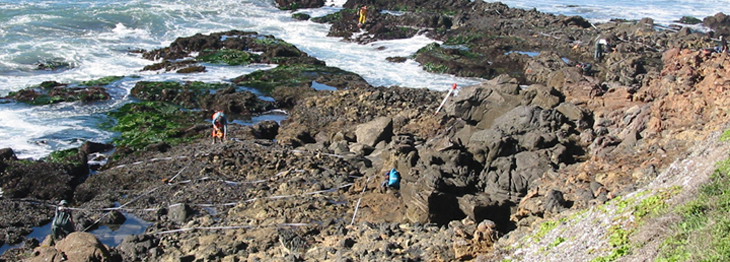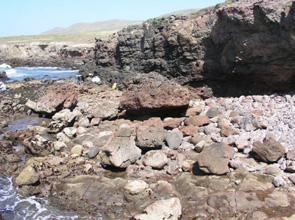Trailer | MARINe
Trailer
Click here for Long-Term trends
Click here for Biodiversity Survey findings
Trailer is located in the Northern Channel Islands, within the Channel Islands National Marine Sanctuary, on Santa Cruz Island, California. This site is located in an Area of Special Biological Significance (San Miguel, Santa Rosa, and Santa Cruz Islands ASBS) in Channel Islands National Park. This site was used as a research site for graduate work (abalone studies) by Brian Tissot and Bill Douros. The west facing reef is rough volcanic rock with a rugose topography. Large cobbles are present between the two rocky benches that form the site. Each bench is about 40 m long with a steep rock cliff behind the site.

Trailer is dominated by a mixture of consolidated volcanic bedrock and boulder fields, and the area surrounding the site is comprised of a mixture of consolidated bedrock, boulder fields, and sandy beach. High tide goes to the base of the cliff. A small sandy beach at the base of a small canyon marks the north end of the site. To the south there are some large boulders on the reef. The primary coastal orientation of this site is west.
Long-Term Monitoring Surveys at Trailer were established in 1994, and are done by Channel Islands National Park. Long-Term MARINe surveys currently target the following species: Chthamalus/Balanus (Acorn Barnacles), Mytilus (California Mussel), Hesperophycus (Olive Rockweed), Silvetia (Golden Rockweed), and Phyllospadix (Surfgrass). In addition, motile invertebrates, mussel size structure, and water temperature are monitored at this site. Click here to view Long-Term trends at this site.

Biodiversity Surveys were done in 2002 and 2006. The Biodiversity Survey grid encompasses two sections that are approximately 15 meters (along shore) x 15 meters (seaward), and 12 meters (along shore) x 15 meters (seaward). Click here to view Biodiversity Survey findings at this site.
For more information about Trailer, please contact Stephen Whitaker (stephen_whitaker@nps.gov).


